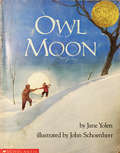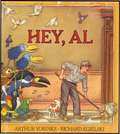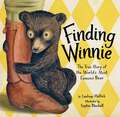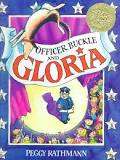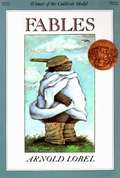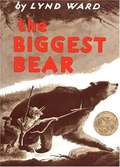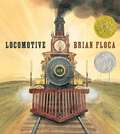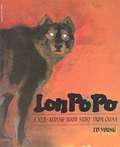Special Collections
Caldecott Award Winners
- Table View
- List View
Owl Moon
by Jane Yolen and John SchoenherrLate one winter night a child and father go owling. The trees stand still as statues and the world is silent as a dream. Wordlessly the two companions walk along, for when you go owling you don't need words. You don't need anything but hope. Sometimes there isn't an owl, but sometimes there is.
Distinguished author Jane Yolen has created a gentle, poetic story that lovingly depicts the special companionship of a child and father as well as humankind's close relationship to the natural world.
Images and image descriptions available.
Once A Mouse... A Fable Cut in Wood
by Marcia BrownFrom the book: "No one shall tell me that I was once a mouse!" roars the tiger. But an old hermit, mighty at magic, does tell him; for it was "he who first changed the tiger from a wretched -little mouse to a stout cat, to a big dog, and finally, to his proud and royal self. Youngest readers will take special delight in seeing these changes take place in Marcia Brown's dramatic picturing of the tiger's fall from grace. Older boys and girls will read more meaning into the text. A rajah of ancient India is said to have had such popular animal fables collected as a "mirror for princes" to instruct his errant sons. Marcia Brown retells this fable from the Hitopadesìa in a vigorous style. This book was the recipient of the 1962 Caldecott Medal.
Hey, Al
by Arthur YorinksAl, a janitor, and his faithful dog, Eddie, live in a single room on the West Side. They eat together, they work together, they do everything together. So what's the problem? You name it. Their tiny home is crowded and cramped; their life is an endless struggle. Al and Eddie are totally miserable until a large and mysterious bird offers them a change of fortune. Transported to a gorgeous island in the sky, they are soon living a life of ease and comfort. But sometimes, they discover, the grass can be a little too green on the other side. After a dramatic escape from their "paradise," both man and dog agree: There really is no place like home. Arthur Yorinks and Richard Egielski have previously collaborated on Sid and Sol, which Maurice Sendak described as "a wonder"; Louis the Fish, named one of the Best Books of 1980 by School Library Journal; and Happened in Pinsk, a Booklist Children's Editors' Choice for 1984.
Finding Winnie
by Sophie Blackall and Lindsay MattickBefore Winnie-the-Pooh, there was a real bear named Winnie. In 1914, Harry Colebourn, a veterinarian on his way to tend horses in World War I, followed his heart and rescued a baby bear. He named her Winnie, after his hometown of Winnipeg, and he took the bear to war. Harry Colebourn's real-life great-granddaughter tells the true story of a remarkable friendship and an even more remarkable journey--from the fields of Canada to a convoy across the ocean to an army base in England...And finally to the London Zoo, where Winnie made another new friend: a real boy named Christopher Robin. Here is the remarkable true story of the bear who inspired Winnie-the-Pooh.
Winner of the Caldecott Medal
Officer Buckle and Gloria
by Peggy RathmannOfficer Buckle is dedicated to teaching schoolchildren important safety tips, such as never put anything in your ear and never stand on a swivel chair. The problem is, Officer Buckle's school assemblies are dull, dull, dull, and the children of Napville just sleep, sleep, sleep. That is, until Gloria the police dog is invited along!
Fables
by Arnold Lobelpig flying through marshmallow clouds to a marzipan moon? A camel pirouetting through the desert? A wolf who looks suspiciously like an apple tree-or is it the other way around? A bear in a frying-pan hat and paper-bag boots? Where can a reader-child or adult -find such marvelous things but in a fable? Arnold Lobel, creator of Frog and Toad, has given us his own funny and true fables. Each with a fresh and unexpected moral. Each accompanied by an illustration of glowing color and rich detail. Indeed, the reader of Arnold Lobel's fables will be rewarded - just like the mouse who goes off to see the world - by many moments of happiness. Winner of the 1981 Caldecott Medal This file should make an excellent embossed braille copy.
The Biggest Bear
by Lynd WardJohnny Orchard brings home a playful bear cub that soon becomes huge and a nuisance to the neighbors.
Winner of the Caldecott Medal
Locomotive
by Brian FlocaIt is the summer of 1869, and trains, crews, and family are traveling together, riding America's brand-new transcontinental railroad. These pages come alive with the details of the trip and the sounds, speed, and strength of the mighty locomotives; the work that keeps them moving; and the thrill of travel from plains to mountain to ocean.
Come hear the hiss of the steam, feel the heat of the engine, watch the landscape race by. Come ride the rails, come cross the young country!
The Caldecott Medal Winner, Sibert Honor Book, and New York Times bestseller Locomotive is a rich and detailed sensory exploration of America's early railroads, from the creator of the "stunning" (Booklist) Moonshot.
Ox-Cart Man
by Donald HallChildren's book about the ox-cart man and his hard work throughout the year.
Lon Po Po
by Ed YoungIn this Chinese version of the classic fairy tale, a mother leaves her three children home alone while she goes to visit their grandmother. When the children are visited by a wolf, pretending to be their Po Po, or granny, they let him in the house, but ultimately are not fooled by his deep voice and hairy face
Winner of the Caldecott Medal
This text is listed as an example that meets Common Core Standards in English language arts for K-1 at http://www.corestandards.org.
